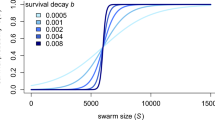Abstract
Eight experimental populations of Drosophila buzzatii were founded with adults derived from the locality of Arroyo Escobar (Argentina). The populations were fed on different trophic substrates for more than 30 generations and periodically a sample of individuals from each of them was studied for chromosomal polymorphism. Considerable changes in the frequencies of second chromosome arrangements occurred in the eight experimental populations and the response varied significantly according to the different treatments. These results show the remarkable influence the trophic substrate has on second-chromosome polymorphism of D. buzzatii.
Similar content being viewed by others
References
Andrewartha, H. G., 1970. Introduction to the study of animal populations. Chapman & Hall, London.
Barker, J. S. F., 1977. Cactus-breeding Drosophila-A system for the measurement of natural selection. In: F. B., Christiansen & T., Fenchel, eds., Measuring sejection in natural populations. Lecture Notes in Biomathematics, vol. 19, Springer, Berlin, pp. 403–430.
Brncic, D., 1970. Studies on the evolutionary biology of Chilean species of Drosophila. In: M. K., Hecht & W. C., Steere, eds. Essays in evolution and genetics in honor of Th. Dobz-hansky. Appleton-Century Crofts, New York, pp. 401–436.
Carson, H. L., 1965. Chromosomal morphism in geographically widespread species of Drosophila. In: H. G., Baker & G. L., Stebbins, eds., The genetics of colonizing species. Academic Press. New York, pp. 503–531.
Carson, H. L. & Wasserman, M., 1965. A widespread chromosomal polymorphism in a widespread species. Drosophila buzzatil. Am. Natur. 99: 111–115.
Da, Cunha, A. B., 1951. Modification of the adaptative values of chromosomal types in Drosophila pseudoobscura by nutritional variables. Evolution 5: 395–404.
Da, Cunha, A. B., 1956. Adaptation of carriers of different chromosomal types in Drosophila willistoni to a variety of environments. Rev. brasil. Biol. 16: 263–272.
David, J., 1959. Etude quantitative du développement de la Drosophile élevée en milleu axénique. Bull. biol. Fr. Belg. 93: 472–505.
David, J. & Tsacas, L., 1980. Cosmopolitan, subcosmopolitan and widespread species: different strategies within the Drosophilid family (Diptera). C.r. Soc. Biogeógr. 57: 11–26.
Dobzhansky, Th., 1962. Rigid versus flexible chromosomal polymorphism in Drosophila. Am. Natur. 96: 321–328.
Dobzhansky, Th. & Spassky, B., 1954. Environmental modification of heterosis in Drosophila pseudoobscura. Proc. natn. Acad. Sci. U.S.A. 40: 407–415.
Fontdevila, A., Ruiz, A., Alonso, G. & Ocaña, J., 1981. The evolutionary history of Drosophila buzzatii. I. Natural chromosomal polymorphism in colonized populations of the Old World. Evolution 35: 148–157.
Fontdevila, A., Ruiz, A., Ocaña, J. & Alonso, G., 1982. The evolutionary history of Drosophila buzzatii. II. How much has chromosomal polymorphism changed in colonization?. Evolution 36: 843–851.
Patterson, J. T. & Stone, W. S., 1952. Evolution in the genus Drosophila. Maemillan, New York.
Prevosti, A., 1974. La distaneia genética entre poblaciones. Miscellanea Aleobe, Public. Univ. Barcolona, 100–118.
Ruiz, A., Fontdevila, A. & Wasserman, M., 1982. The evolutionary history of Drosophila buzzatil, III. Cytogenetic relationships between two sibling species of the buzzatii cluster. Genetics 101: 503–518.
Ruiz, A., Naveira, H. & Fontdevila, A. La historia evolutiva de Drosophila buzzatii. IV. Aspectos citogenéticos de su polimorfismo cromosómico. Genética ibérica (in press).
Ruiz, A., Naveira, H. & Fontdevila. A. The evolutionary history of Drosophila buzzatii. V. Differential survivorship on Opuntia between D. buzzatii and D. serido. Experientia (in press).
Vilela, C. R., 1983. A revision of the Drosophila repleta species group (Diptera, Drosophilidae). Rev. brasil. Entomol. 27: 1–114.
Waddington, C. H., 1965. Introduction to the Symposium. In: H. G., Baker & G. L., Stebbins, eds, The genetics of colonizing species. Academic Press, New York, pp. 1–6.
Wasserman, M., 1962. Cytological studies of the repleta group of the genus Drosophila. V. The mulleri subgroup. Texas Univ. Publ. 6205: 85–117.
Author information
Authors and Affiliations
Rights and permissions
About this article
Cite this article
Ruiz, A., Fontdevila, A. The evolutionary history of Drosophila buzzatii VI. Adaptive chromosomal changes in experimental populations with natural substrates. Genetica 66, 63–71 (1985). https://doi.org/10.1007/BF00123606
Received:
Accepted:
Issue Date:
DOI: https://doi.org/10.1007/BF00123606




